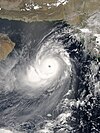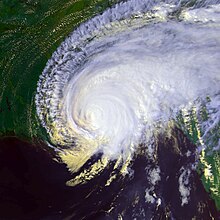The Tropical Cyclones Portal

A tropical cyclone is a storm system characterized by a large low-pressure center, a closed low-level circulation and a spiral arrangement of numerous thunderstorms that produce strong winds and heavy rainfall. Tropical cyclones feed on the heat released when moist air rises, resulting in condensation of water vapor contained in the moist air. They are fueled by a different heat mechanism than other cyclonic windstorms such as Nor'easters, European windstorms and polar lows, leading to their classification as "warm core" storm systems. Most tropical cyclones originate in the doldrums, approximately ten degrees from the Equator.
The term "tropical" refers to both the geographic origin of these systems, which form almost exclusively in tropical regions of the globe, as well as to their formation in maritime tropical air masses. The term "cyclone" refers to such storms' cyclonic nature, with anticlockwise rotation in the Northern Hemisphere and clockwise rotation in the Southern Hemisphere. Depending on its location and intensity, a tropical cyclone may be referred to by names such as "hurricane", "typhoon", "tropical storm", "cyclonic storm", "tropical depression" or simply "cyclone".
Types of cyclone: 1. A "Typhoon" is a tropical cyclone located in the North-west Pacific Ocean which has the most cyclonic activity and storms occur year-round. 2. A "Hurricane" is also a tropical cyclone located at the North Atlantic Ocean or North-east Pacific Ocean which have an average storm activity and storms typically form between May 15 and November 30. 3. A "Cyclone" is a tropical cyclone that occurs in the South Pacific and Indian Oceans.
Selected named cyclone -
Hurricane Agatha was the strongest hurricane to make landfall along the Pacific coast of Mexico in the month of May since records began in 1949. The first named storm and the first hurricane of the 2022 Pacific hurricane season, Agatha originated from a surface trough south of the Gulf of Tehuantepec. It steadily organized into a tropical depression early on May 28 and within hours intensified into Tropical Storm Agatha. Amid favorable environmental conditions, the cyclone underwent rapid intensification on May 29, strengthening into a Category 2 hurricane and reaching peak winds of 110 mph (180 km/h). Though the storm moved west-northwest early on, it curved toward the northeast in response to weakening high pressure over Mexico. On the afternoon of May 30, the hurricane made landfall just west of Puerto Ángel, Oaxaca, with slightly weaker winds of 105 mph (169 km/h).
Agatha weakened rapidly as it moved inland, and soon dissipated. Heavy rain brought by the storm triggered landslides and flash flooding, killing at least 9 and left 6 missing in Oaxaca. Aon estimated that total losses reached at least $50 million (2022 USD), with the National Hurricane Center later saying, “no monetary damage figures are currently available.” (Full article...)Selected article -
The effects of Hurricane Georges in Louisiana included $30.1 million in damage and three deaths. Forming from a tropical wave over the Atlantic Ocean, Georges attained a peak intensity of 155 mph (249 km/h) on September 20, 1998. Over the following several days, the storm tracked through the Greater Antilles and later entered the Gulf of Mexico on September 28, the Category 2 storm made landfall in Mississippi before dissipating on October 1. Before landfall, about 500,000 residents in Louisiana evacuated from low-lying areas. The mayor of New Orleans declared a state of emergency to allow federal assistance into the state. After nearly 1.5 million people were urged to evacuate coastal areas, officials described the evacuation as "probably the largest [...] we have ever achieved".
Numerous homes located outside the levee system were flooded by the storm surge, and 85 fishing camps on the banks of Lake Pontchartrain were destroyed. An estimated 160,000 residences were left without power due to Georges and severe beach erosion took place due to the slow movement of the hurricane. Precipitation statewide peaked at 2.98 inches (76 mm) in Bogalusa, and wind gusts reached 82 mph (132 km/h). In the wake of the hurricane, the Federal Emergency Management Agency (FEMA) opened 67 shelters throughout the state, and covered insurance claims totalling $14,150,532, including from Puerto Rico and Mississippi. The Clinton administration appropriated $56 million in disaster relief to regions in Louisiana for recovery from Tropical Storm Frances and Hurricane Georges. (Full article...)Selected image -

Selected season -

The 2009 North Indian Ocean cyclone season was an event in the annual cycle of tropical cyclone formation. The North Indian Ocean cyclone season has no official bounds, but cyclones tend to form between April and December, with peaks in May and November. These dates conventionally delimit the period of each year when most tropical cyclones form in the northern Indian Ocean.
The scope of this article is limited to the Indian Ocean in the Northern Hemisphere, east of the Horn of Africa and west of the Malay Peninsula. There are two main seas in the North Indian Ocean — the Arabian Sea to the west of the Indian subcontinent, abbreviated ARB by the India Meteorological Department (IMD); and the Bay of Bengal to the east, abbreviated BOB by the IMD. (Full article...)Related portals
Currently active tropical cyclones

Italicized basins are unofficial.
- North Atlantic (2024)
- No active systems
- East and Central Pacific (2024)
- No active systems
- West Pacific (2024)
- No active systems
- North Indian Ocean (2024)
- No active systems
- Mediterranean (2023–24)
- No active systems
- South-West Indian Ocean (2023–24)
- No active systems
- Australian region (2023–24)
- No active systems
- South Pacific (2023–24)
- No active systems
- South Atlantic (2023–24)
- No active systems
Last updated: 21:50, 2 June 2024 (UTC)
Tropical cyclone anniversaries
June 3,
- 1982 - Tropical Storm 02B made landfall in India near Paradip, killing 140 people and destroying half a million homes.
- 2010 - Cyclone Phet struck eastern Oman, dropping heavy rainfall across normally arid areas; the storm killed 47 people and left US$861 million in damage.
- 2014 - Tropical Storm Boris makes landfall over in Southwestern Mexico as a weak system, killing a total of six people and US$46.8 million worth of damages.

June 4
- 2006 - Cyclone Gonu (pictured) became the strongest tropical cyclone on record in the Arabian Sea, with 3-minute winds of 155 km/h (100 mph); two days later, Gonu struck the Arabian Peninsula, killing 49 people and causing about $4 billion of damage.
- 2012 - Typhoon Mawar reaches peak intensity as a Category 3 typhoon.
- 2014 - Tropical Storm Boris makes landfall over Southwestern Mexico and kills 6 people with US$46.8 million in damages.

June 5
- 1890 - A cyclone struck northeastern Oman, killing 727 people from its floods.
- 2001 - Tropical Storm Allison (pictured) formed over the northern Gulf of Mexico and made landfall in Southeast Texas. Allison caused record levels of rainfall along much of its path, with the resulting flooding killing 41 people and causing US$5.5 billion of damage, making Allison the costliest tropical storm on record.
- 2003 - Cyclone Epi developed east of Papua New Guinea.
Did you know…




- …that the Joint Typhoon Warning Center considers that Typhoon Vera (pictured) of 1986 is actually two distinct systems, formed from two separated low-level circulations?
- …that Hurricane Agatha (pictured) was the strongest Pacific hurricane to make landfall in Mexico in May since records began in 1949?
- …that Cyclone Raquel (track pictured) travelled between the Australian and South Pacific basins between the 2014–15 and 2015–16 seasons, spanning both seasons in both basins?
- …that Cyclone Amphan (pictured) in 2020 was the first storm to be classified as a Super Cyclonic Storm in the Bay of Bengal since 1999?
General images -

Category 3 is the third-highest classification on the Saffir–Simpson hurricane wind scale, and categorizes tropical cyclones with 1-minute maximum sustained winds between 96 and 112 knots (110 and 129 mph; 178 and 207 km/h; 49 and 58 m/s). Tropical cyclones that attain such winds and move over land while maintaining those winds are capable of causing severe damage to human lives and infrastructure. From 1949 to 2023, a total of 85 recorded Pacific hurricanes have peaked at Category 3 strength within the Northeast Pacific tropical cyclone basin, which is denoted as the part of the Pacific Ocean north of the equator and east of the International Date Line. This does not include storms that also attained Category 4 or 5 status on the scale.
The development of Category 3 hurricanes in the Northeast Pacific basin is influenced by many factors. During the Northern Hemisphere winter and spring months of December to April, sea surface temperatures in the tropics are usually too low to support tropical cyclogenesis. Furthermore, from January to April, the North Pacific High and Aleutian Low induce strong vertical wind shear and unfavorable conditions that serve to prevent the development of hurricanes. These effects are reduced or even disappear during hurricane season from May to November, when sea surface temperatures are also high enough to support tropical cyclogenesis; the bulk of recorded Category 3 hurricanes developed during June to October. Global weather patterns may also influence hurricane development in the Northeast Pacific. El Niño events result in increased numbers of powerful hurricanes through weaker wind shear and higher sea surface temperatures within the basin, while La Niña events reduce the number of such hurricanes through the opposite. (Full article...)Topics
Subcategories
Related WikiProjects
WikiProject Tropical cyclones is the central point of coordination for Wikipedia's coverage of tropical cyclones. Feel free to help!
WikiProject Weather is the main center point of coordination for Wikipedia's coverage of meteorology in general, and the parent project of WikiProject Tropical cyclones. Three other branches of WikiProject Weather in particular share significant overlaps with WikiProject Tropical cyclones:
- The Non-tropical storms task force coordinates most of Wikipedia's coverage on extratropical cyclones, which tropical cyclones often transition into near the end of their lifespan.
- The Floods task force takes on the scope of flooding events all over the world, with rainfall from tropical cyclones a significant factor in many of them.
- WikiProject Severe weather documents the effects of extreme weather such as tornadoes, which landfalling tropical cyclones can produce.
Things you can do
 |
Here are some tasks awaiting attention:
|
Wikimedia
The following Wikimedia Foundation sister projects provide more on this subject:
-
Commons
Free media repository -
Wikibooks
Free textbooks and manuals -
Wikidata
Free knowledge base -
Wikinews
Free-content news -
Wikiquote
Collection of quotations -
Wikisource
Free-content library -
Wikiversity
Free learning tools -
Wikivoyage
Free travel guide -
Wiktionary
Dictionary and thesaurus























































